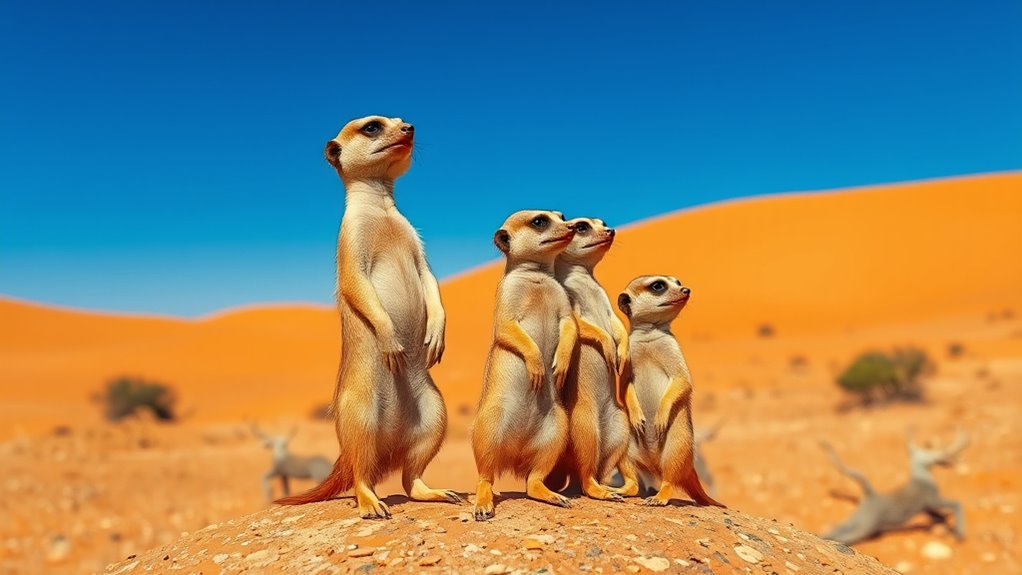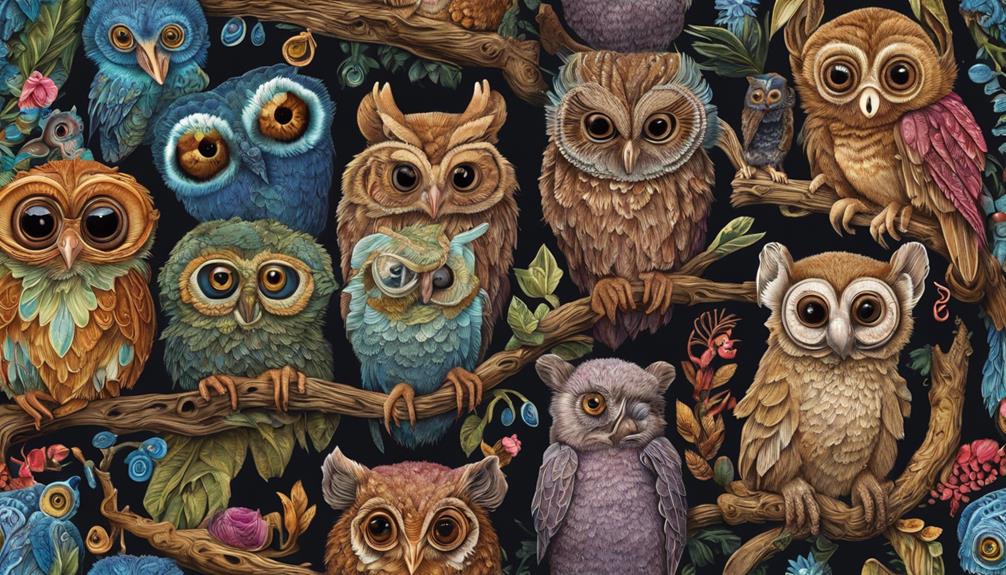Meerkats thrive in the harsh Kalahari Desert, constantly on the move as they forage for food and stand guard against predators. Living in large groups called mobs, they display a fascinating social hierarchy where each member plays a role, from protectors to playful pups. Their intricate burrow systems showcase their adaptability, providing shelter and safety. Through teamwork and communication, they ensure their survival in this challenging environment. Discover more about their enthralling lives and behaviors.
Key Takeaways
- Meerkats thrive in the Kalahari Desert, showcasing sociable behavior and constant movement while foraging for food in their harsh environment.
- Their social structure features a dominant pair leading the mob, with others assisting in raising young and maintaining group dynamics.
- Complex underground burrows provide shelter and protection from predators, demonstrating their ingenuity and adaptability to desert conditions.
- Cooperative behaviors among meerkats are essential for survival, as they work together to find food and maintain their living spaces.
- Rich communication through chirps and calls reinforces community bonds and enhances their ability to detect threats in the Kalahari.

As you step into the vast, sun-soaked landscapes of the Kalahari Desert, you can’t help but notice the lively meerkats darting about. These small, sociable creatures are always on the move, their sleek bodies working together in a remarkable display of coordination. You’ll find them standing sentry, noses twitching, as they keep watch for potential predators like eagles or snakes. Their energetic antics capture your attention, but it’s their intricate social structure that truly fascinates you.
Meerkats live in large groups, known as mobs, where their social hierarchy is evident. You quickly learn that each member has a role, from the vigilant sentinels to the playful pups. The dominant pair in the mob leads the pack, often breeding while the others assist in raising the young. As you observe, you see how the hierarchy influences their interactions. Subordinates groom the dominant couple, ensuring their status is maintained and reinforcing bonds within the group. It’s a fascinating dance of cooperation and competition that keeps their community thriving.
The burrow architecture of meerkat homes is equally impressive. You can’t help but marvel at the complex underground networks they construct. These burrows serve as both shelter from the harsh desert sun and a safe haven from predators. As you watch them work, you notice how members dig, clean, and even renovate their homes, displaying a collaborative spirit that’s essential for survival. The burrows can extend several meters deep, with multiple entrances that allow for quick escapes if danger arises. It’s this ingenuity that showcases their adaptability to the challenging environment of the Kalahari.
The meerkats’ behavior is a tribute to their intelligence and resourcefulness. You see them foraging together, searching for insects, roots, and even small reptiles. Their communication is rich and varied, with chirps and calls that convey messages about food, threats, and group dynamics. You can’t help but appreciate how their social interactions create a strong sense of community, essential for their survival in such a harsh landscape. Additionally, their cooperative behavior parallels the importance of community found in many animal species, showcasing how social structures can enhance survival.
As the sun sets over the Kalahari, painting the sky in hues of orange and pink, you reflect on the mesmerizing lives of these meerkats. Their burrow architecture, social hierarchy, and cooperative behavior reveal not just a survival mechanism but a vibrant social tapestry, making the Kalahari a living theater of nature’s wonders.
Frequently Asked Questions
What Do Meerkats Eat in the Wild?
In the wild, meerkats primarily eat insects, small rodents, and plant matter. When you observe meerkat foraging, you’ll notice they dig for larvae and hunt for scorpions. Their diet varies based on the availability of food in their environment, so they adapt their foraging techniques accordingly. This flexibility guarantees they get the nutrition they need to survive. You might be surprised by how resourceful these little creatures can be!
How Long Do Meerkats Live in Captivity?
In the domain of animal care, a meerkat’s lifespan can be a remarkable testament to proper management. When you consider meerkats in captivity, their lifespan often extends to around 12 to 14 years, considerably longer than their wild counterparts. This captivity duration allows for better health and protection from predators. By providing a safe environment and adequate care, you can help these fascinating creatures thrive well beyond their natural years.
Are Meerkats Solitary or Social Animals?
Meerkats aren’t solitary; they’re highly social animals that thrive in groups. Their social structure is complex, with cooperative behavior being key to their survival. You’ll often see them foraging together, taking turns standing guard, and caring for each other’s young. This teamwork helps them face predators and find food more effectively. Their strong bonds within the group showcase their unique social dynamics, making them fascinating creatures to observe.
How Do Meerkats Communicate With Each Other?
Meerkats communicate like they’re throwing a wild concert! Through a variety of meerkat vocalizations, they convey messages about danger, food, and social bonding. You’ll hear chirps, barks, and growls, each serving a purpose. When one meerkat spots a predator, it emits a specific call to alert the group. This coordination strengthens their social bonds, ensuring everyone’s on the same page and ready to react, making their communication crucial for survival.
What Threats Do Meerkats Face in Their Habitat?
Meerkats face several threats in their habitat, including predator threats from birds of prey, snakes, and larger mammals. These predators can quickly eliminate members of their group. Additionally, drought impacts their environment, reducing food availability and water sources. When conditions become harsh, meerkats struggle to find sustenance, leaving them vulnerable to starvation. To survive, they must adapt and remain vigilant against these dangers lurking in the Kalahari.
Conclusion
In the Kalahari, meerkats thrive like tight-knit families, always watching out for one another. Imagine standing in the sun, surrounded by friends who’ve got your back, just like these little guardians. They teach us that life’s challenges are easier when faced together. So, next time you’re guiding your own desert, remember the meerkats. Lean on your crew, stay alert, and embrace each moment—because together, you can conquer even the harshest of terrains.









